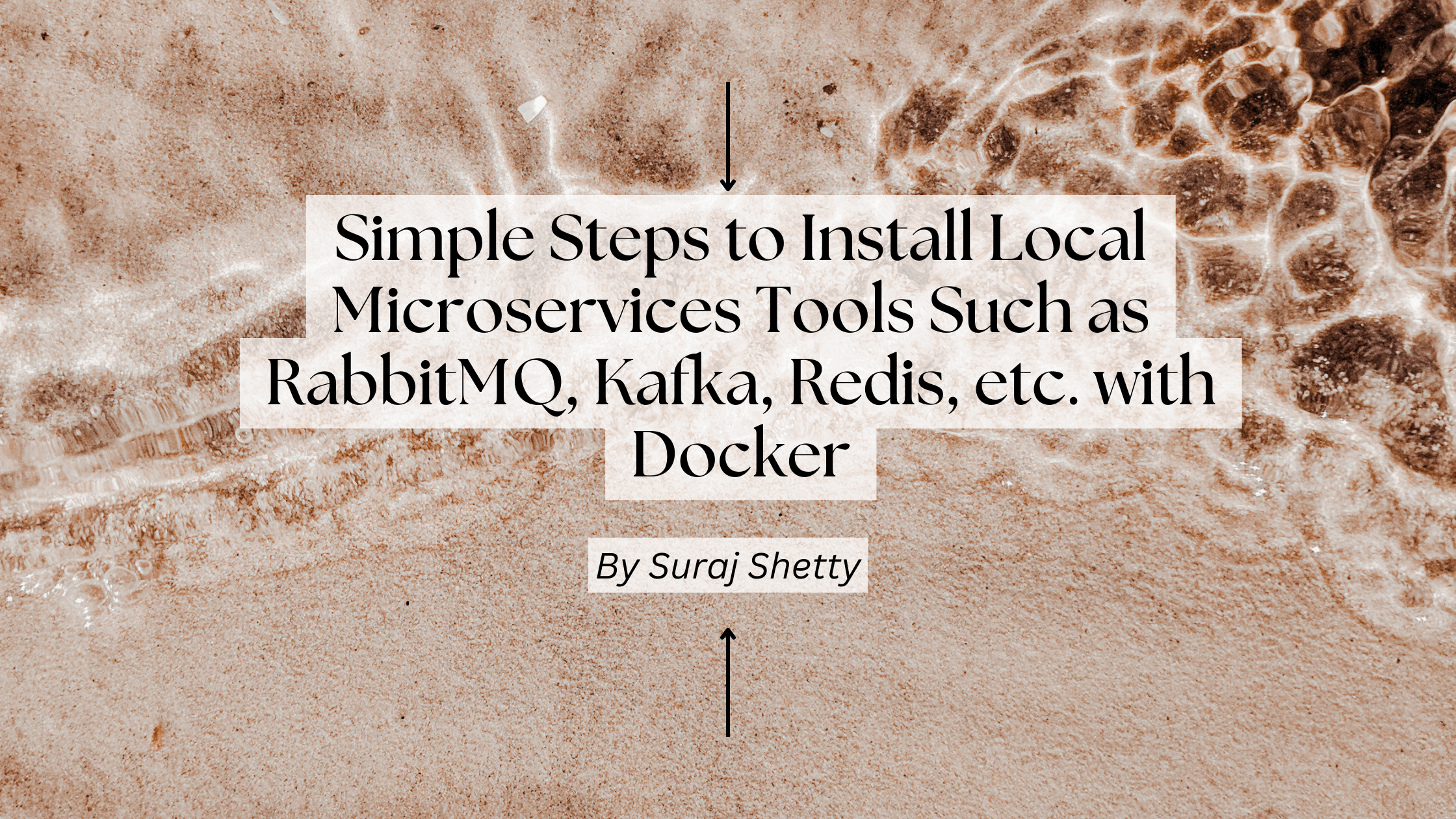Simple Steps to Install Local Microservices Tools Such as RabbitMQ, Kafka, Redis, etc. with Docker
 Suraj Shetty
Suraj Shetty
Let's first understand what Docker is and the features of containerization.
Docker is a platform that enables developers to develop, ship, and run applications in containers. Containers allow you to package an application with all its dependencies into a standardized unit for software development. Docker provides tools and a platform to manage these containers efficiently.
Here are the key components of Docker:
Docker Engine: The core component of Docker. It's a lightweight runtime and packaging tool for containers. Docker Engine enables you to create, manage, and run containers on a host machine.
Docker Image: An immutable, standalone, and executable package that contains all the necessary dependencies (libraries, binaries, code, runtime, etc.) to run an application. Images are the building blocks of containers.
Docker Container: An instance of a Docker image that runs as a process on the host machine's operating system. Containers are lightweight, portable, and isolated environments that run applications.
Now, let's talk about Docker Compose:
Docker Compose is a tool that lets you define and run multi-container Docker applications using a YAML file to set up services, networks, and volumes, simplifying the management of complex applications and their dependencies.
A Docker Compose file (docker-compose.yml) defines your application's services configuration, including services, networks, and volumes sections.
Below is an example of an nginx and MySQL configuration in a docker-compose file.
Here's a step-by-step explanation of a Docker Compose file:
version: '3.8' # Version of the Docker Compose file format
services: # Defines the services/containers in your application
web: # Name of the service
image: nginx:alpine # Docker image to use for this service
ports:
- "8080:80" # Maps port 8080 on the host to port 80 on the container
volumes:
- ./nginx.conf:/etc/nginx/nginx.conf # Mounts a local file into the container
networks:
- my-network # Specifies the network the container should connect to
db: # Another service for database
image: mysql:5.7
environment:
MYSQL_ROOT_PASSWORD: example # Environment variables for the container
volumes:
- db-data:/var/lib/mysql # Mounts a volume to persist data
networks:
- my-network
networks: # Defines networks for your application
my-network: # Name of the network
driver: bridge # Specifies the network driver
volumes: # Defines volumes for your application
db-data: # Name of the volume
Explanation of the Docker Compose file:
version: Specifies the version of the Docker Compose file format. services: Defines the services/containers in your application, with each service consisting of configuration options such as image, ports, volumes, environment variables, etc. networks: Defines networks for your application, enabling communication between containers. volumes: Defines volumes for your application, allowing you to persist data across container restarts.
This Docker Compose file specifies two services (web using the Nginx image, exposing port 8080, mounting a local config file, and db using the MySQL image, setting environment variables, persisting data with a volume), a network (my-network), and a volume (db-data), with both services connecting to my-network.
You can run docker-compose up command in the directory containing the docker-compose.yml file to start your application defined in the Docker Compose file. Similarly, you can use docker-compose down to stop and remove the containers.
Now that you understand what Docker and Docker Compose files are, there's a list of microservice tools accompanied by their Docker Compose files. These can be used for local setup and integrated into your project.
RabbitMQ
RabbitMQ is an open-source message-broker software that initially supported the Advanced Message Queuing Protocol but now includes a plug-in architecture for other protocols like Streaming Text Oriented Messaging Protocol and MQ Telemetry Transport.
version: "3.2"
services:
rabbitmq:
image: rabbitmq:3-management
container_name: 'rabbitmq-container'
hostname: rabbitmq
ports:
- 5672:5672
- 15672:15672
volumes:
- ~/.docker-conf/rabbitmq/data/:/var/lib/rabbitmq/
- ~/.docker-conf/rabbitmq/log/:/var/log/rabbitmq
networks:
- rabbitmq_go_net
networks:
rabbitmq_go_net:
driver: bridge
Elastic Stack (Elasticsearch, Logstash, Kibana)
A set of tools that can securely and reliably gather data from any source, in any format, and then allow you to search, analyze, and visualize it in real-time.
version: '3'
services:
elasticsearch:
image: docker.elastic.co/elasticsearch/elasticsearch:7.15.2
container_name: elasticsearch
environment:
- discovery.type=single-node
ports:
- "9200:9200"
networks:
- elastic
kibana:
image: docker.elastic.co/kibana/kibana:7.15.2
container_name: kibana
environment:
ELASTICSEARCH_URL: http://elasticsearch:9200
ports:
- "5601:5601"
networks:
- elastic
logstash:
image: docker.elastic.co/logstash/logstash:7.15.2
container_name: logstash
volumes:
- ./logstash-config/:/usr/share/logstash/pipeline/
environment:
LS_JAVA_OPTS: "-Xmx256m -Xms256m"
ports:
- "5000:5000"
- "9600:9600"
networks:
- elastic
sample_data:
image: docker.elastic.co/beats/metricbeat:7.15.2
container_name: sample_data
command: metricbeat -e -E output.elasticsearch.hosts=["elasticsearch:9200"]
depends_on:
- elasticsearch
networks:
- elastic
networks:
elastic:
Note: You might encounter errors when using the Elastic Stack due to the Java JDK dependency.
Apache Kafka
A distributed event store and stream-processing platform
version: "2"
services:
zookeeper:
image: docker.io/bitnami/zookeeper:3.8
ports:
- "2181:2181"
volumes:
- "zookeeper_data:/bitnami"
environment:
- ALLOW_ANONYMOUS_LOGIN=yes
kafka:
image: docker.io/bitnami/kafka:3.3
ports:
- "9092:9092"
volumes:
- "kafka_data:/bitnami"
environment:
- KAFKA_CFG_ZOOKEEPER_CONNECT=zookeeper:2181
- ALLOW_PLAINTEXT_LISTENER=yes
depends_on:
- zookeeper
volumes:
zookeeper_data:
driver: local
kafka_data:
driver: local
Redis
Redis, previously open-source and now "source available," serves as a distributed, in-memory key-value database, cache, and message broker, offering optional durability.
version: '3.6'
services:
redis:
container_name: redis-container
image: "redis:alpine"
hostname: redis
ports:
- "6379:6379"
networks:
- app-network
networks:
app-network:
driver: bridge
Prometheus and Grafana
Grafana and Prometheus are leading tools in application monitoring and analytics, with Prometheus being an open-source platform for monitoring and alerting that collects and stores metrics as time-series data, and Grafana as an open-source web application for analytics and interactive visualization.
version: '3'
volumes:
prometheus-data:
driver: local
grafana-data:
driver: local
services:
prometheus:
image: prom/prometheus:latest
container_name: prometheus
ports:
- "9090:9090"
volumes:
- ./config/prometheus.yml:/etc/prometheus/prometheus.yml
- prometheus-data:/prometheus
restart: unless-stopped
command:
- "--config.file=/etc/prometheus/prometheus.yml"
networks:
- monitoring
grafana:
image: grafana/grafana-oss:latest
container_name: grafana
ports:
- "3000:3000"
volumes:
- grafana-data:/var/lib/grafana
restart: unless-stopped
networks:
- monitoring
cadvisor:
image: gcr.io/cadvisor/cadvisor:v0.45.0
container_name: cadvisor
ports:
- "8080:8080"
volumes:
- /:/rootfs:ro
- /var/run:/var/run:ro
- /sys:/sys:ro
- /var/lib/docker/:/var/lib/docker:ro
- /dev/disk/:/dev/disk:ro
devices:
- /dev/kmsg
restart: unless-stopped
privileged: true
networks:
- monitoring
node_exporter:
image: quay.io/prometheus/node-exporter:latest
container_name: node_exporter
command:
- '--path.rootfs=/host'
pid: host
restart: unless-stopped
volumes:
- '/:/host:ro,rslave'
networks:
- monitoring
networks:
monitoring:
SonarQube
SonarQube, developed by SonarSource, is an open-source platform for continuous code quality inspection, automatically reviewing code with static analysis to identify bugs and code smells across 29 programming languages.
version: '3'
services:
sonarqube:
image: sonarqube:latest
container_name: sonarqube
ports:
- "9000:9000"
environment:
- SONARQUBE_JDBC_URL=jdbc:postgresql://sonarqube-db:5432/sonar
- SONARQUBE_JDBC_USERNAME=sonar
- SONARQUBE_JDBC_PASSWORD=sonar
networks:
- sonarnet
depends_on:
- sonarqube-db
sonarqube-db:
image: postgres:alpine
container_name: sonarqube-db
environment:
- POSTGRES_USER=sonar
- POSTGRES_PASSWORD=sonar
- POSTGRES_DB=sonar
networks:
- sonarnet
networks:
sonarnet:
driver: bridge
Conclusion:
There might be challenges when installing Docker on your system, or you might encounter errors with the Docker Compose file. Working with microservices and integration can be tough at the beginning, but once you understand how to use this tool, it becomes as easy as pie.
Thanks For Reading This Blog.
Subscribe to my newsletter
Read articles from Suraj Shetty directly inside your inbox. Subscribe to the newsletter, and don't miss out.
Written by

Suraj Shetty
Suraj Shetty
Passionate backend developer with a strong foundation in designing and implementing scalable and efficient server-side solutions. Specialized in creating robust APIs and database management. Committed to staying ahead in technology trends, I have a keen interest in DevOps practices, aiming to bridge the gap between development and operations for seamless software delivery. Eager to contribute to innovative projects and collaborate with like-minded professionals in the tech community. Let's connect and explore the possibilities of creating impactful solutions together! #BackendDevelopment #DevOps #TechInnovation